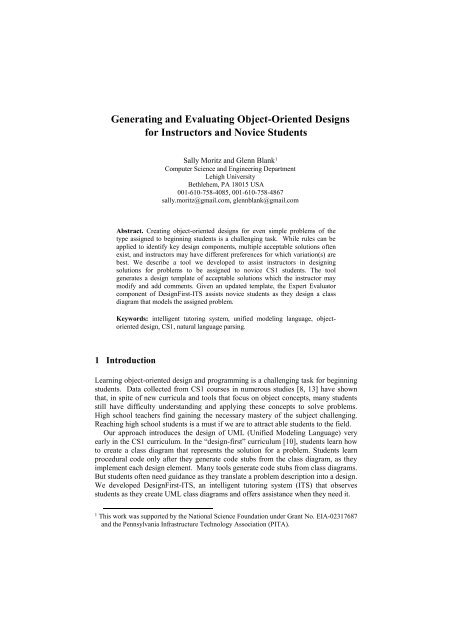Intelligent Tutoring Systems for Ill-Defined Domains - Philippe ...
Intelligent Tutoring Systems for Ill-Defined Domains - Philippe ...
Intelligent Tutoring Systems for Ill-Defined Domains - Philippe ...
You also want an ePaper? Increase the reach of your titles
YUMPU automatically turns print PDFs into web optimized ePapers that Google loves.
Generating and Evaluating Object-Oriented Designs<br />
<strong>for</strong> Instructors and Novice Students<br />
Sally Moritz and Glenn Blank 1<br />
Computer Science and Engineering Department<br />
Lehigh University<br />
Bethlehem, PA 18015 USA<br />
001-610-758-4085, 001-610-758-4867<br />
sally.moritz@gmail.com, glennblank@gmail.com<br />
Abstract. Creating object-oriented designs <strong>for</strong> even simple problems of the<br />
type assigned to beginning students is a challenging task. While rules can be<br />
applied to identify key design components, multiple acceptable solutions often<br />
exist, and instructors may have different preferences <strong>for</strong> which variation(s) are<br />
best. We describe a tool we developed to assist instructors in designing<br />
solutions <strong>for</strong> problems to be assigned to novice CS1 students. The tool<br />
generates a design template of acceptable solutions which the instructor may<br />
modify and add comments. Given an updated template, the Expert Evaluator<br />
component of DesignFirst-ITS assists novice students as they design a class<br />
diagram that models the assigned problem.<br />
Keywords: intelligent tutoring system, unified modeling language, objectoriented<br />
design, CS1, natural language parsing.<br />
1 Introduction<br />
Learning object-oriented design and programming is a challenging task <strong>for</strong> beginning<br />
students. Data collected from CS1 courses in numerous studies [8, 13] have shown<br />
that, in spite of new curricula and tools that focus on object concepts, many students<br />
still have difficulty understanding and applying these concepts to solve problems.<br />
High school teachers find gaining the necessary mastery of the subject challenging.<br />
Reaching high school students is a must if we are to attract able students to the field.<br />
Our approach introduces the design of UML (Unified Modeling Language) very<br />
early in the CS1 curriculum. In the ―design-first‖ curriculum [10], students learn how<br />
to create a class diagram that represents the solution <strong>for</strong> a problem. Students learn<br />
procedural code only after they generate code stubs from the class diagram, as they<br />
implement each design element. Many tools generate code stubs from class diagrams.<br />
But students often need guidance as they translate a problem description into a design.<br />
We developed DesignFirst-ITS, an intelligent tutoring system (ITS) that observes<br />
students as they create UML class diagrams and offers assistance when they need it.<br />
1 This work was supported by the National Science Foundation under Grant No. EIA-02317687<br />
and the Pennsylvania Infrastructure Technology Association (PITA).


